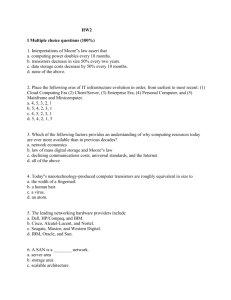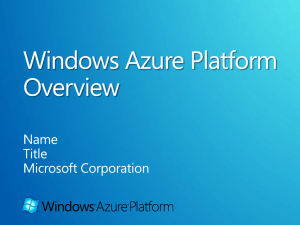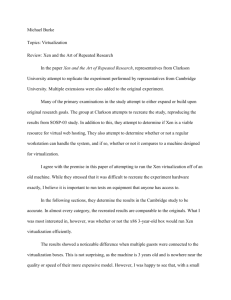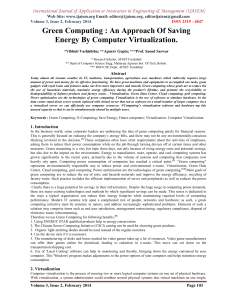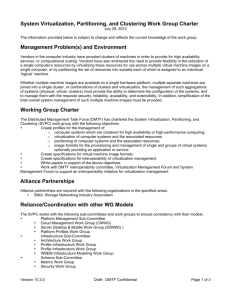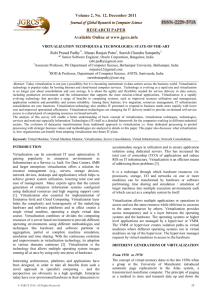cloud-Computing-question-bank
advertisement
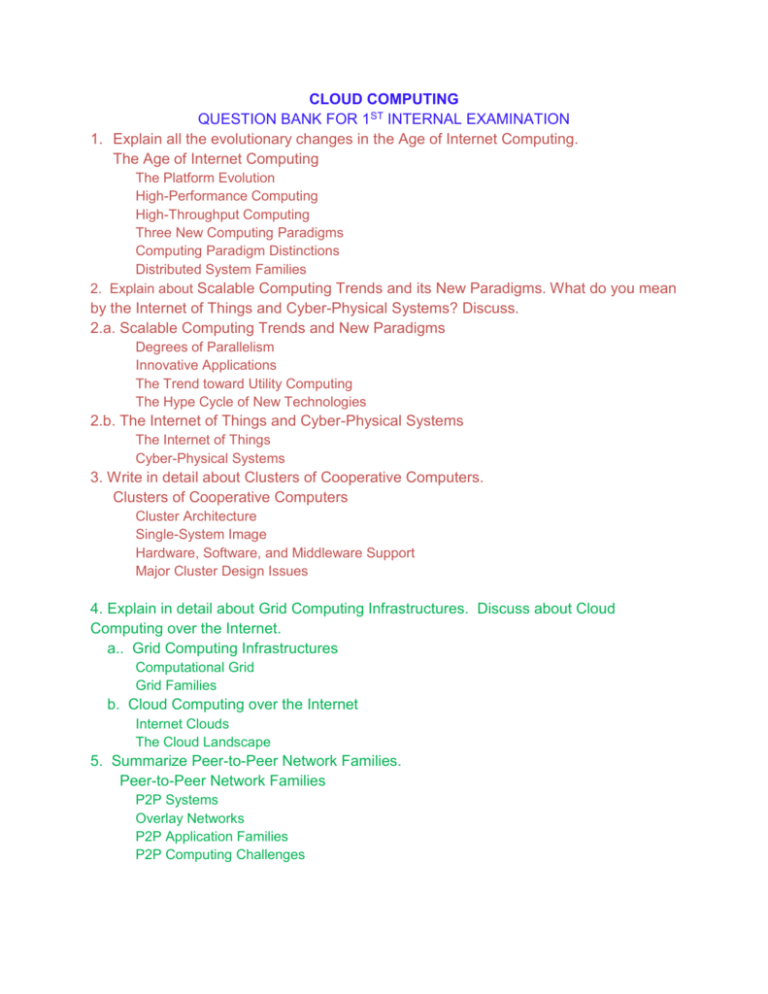
CLOUD COMPUTING QUESTION BANK FOR 1ST INTERNAL EXAMINATION 1. Explain all the evolutionary changes in the Age of Internet Computing. The Age of Internet Computing The Platform Evolution High-Performance Computing High-Throughput Computing Three New Computing Paradigms Computing Paradigm Distinctions Distributed System Families 2. Explain about Scalable Computing Trends and its New Paradigms. What do you mean by the Internet of Things and Cyber-Physical Systems? Discuss. 2.a. Scalable Computing Trends and New Paradigms Degrees of Parallelism Innovative Applications The Trend toward Utility Computing The Hype Cycle of New Technologies 2.b. The Internet of Things and Cyber-Physical Systems The Internet of Things Cyber-Physical Systems 3. Write in detail about Clusters of Cooperative Computers. Clusters of Cooperative Computers Cluster Architecture Single-System Image Hardware, Software, and Middleware Support Major Cluster Design Issues 4. Explain in detail about Grid Computing Infrastructures. Discuss about Cloud Computing over the Internet. a.. Grid Computing Infrastructures Computational Grid Grid Families b. Cloud Computing over the Internet Internet Clouds The Cloud Landscape 5. Summarize Peer-to-Peer Network Families. Peer-to-Peer Network Families P2P Systems Overlay Networks P2P Application Families P2P Computing Challenges 6. Illustrate Service-Oriented Architecture (SOA). Service-Oriented Architecture (SOA) Layered Architecture for Web Services and Grids Web Services and Tools The Evolution of SOA Grids versus Clouds 7. Analyze various Trends toward Distributed Operating Systems. Trends toward Distributed Operating Systems Distributed Operating Systems Amoeba versus DCE MOSIX2 for Linux Clusters Transparency in Programming Environments 8 Write about all Parallel and Distributed Programming Models in detail. Parallel and Distributed Programming Models Message-Passing Interface (MPI) MapReduce Hadoop Library Open Grid Services Architecture (OGSA) Globus Toolkits and Extensions 9 What are the Performance Metrics and Scalability Analysis do you use? Discuss. Performance Metrics and Scalability Analysis Performance Metrics Dimensions of Scalability Scalability versus OS Image Count Amdahl’s Law Problem with Fixed Workload Gustafson’s Law 10 .Discuss about Network Threats and Data Integrity in detail.. What do you mean by Fault Tolerance and System Availability ? a. Network Threats and Data Integrity Threats to Systems and Networks Security Responsibilities Copyright Protection System Defense Technologies Data Protection Infrastructure b. Fault Tolerance and System Availability 11 What are the measures will you take to use Energy Efficiently in Distributed Computing. Energy Efficiency in Distributed Computing Energy Consumption of Unused Servers Reducing Energy in Active Servers Application Layer Middleware Layer Resource Layer Network Layer DVFS Method for Energy Efficiency 12 Explain about all the Design Objectives of Computer Clusters Design Objectives of Computer Clusters Scalability Packaging Control Homogeneity Security Dedicated versus Enterprise Clusters 13 What are the Fundamental Cluster Design Issues do we have? Explain. Fundamental Cluster Design Issues Scalable Performance Single-System Image (SSI) Availability Support Cluster Job Management Inter node Communication Fault Tolerance and Recovery Cluster Family Classification 14. Discuss in detail about all the Levels of Virtualization Implementation. Levels of Virtualization Implementation Instruction Set Architecture Level Hardware Abstraction Level Operating System Level Library Support Level User-Application Level Relative Merits of Different Approaches 15. a. How Virtualization Support at the OS Level? Give all the requirements for VMM Desin. How Middleware extends its Support for Virtualization? 15.a. Virtualization Support at the OS Level Why OS-Level Virtualization? Advantages of OS Extensions Disadvantages of OS Extensions Virtualization on Linux or Windows Platforms 15.b. VMM Design Requirements 15.c. Middleware Support for Virtualization

